| 1 | How much salmon do they eat? |
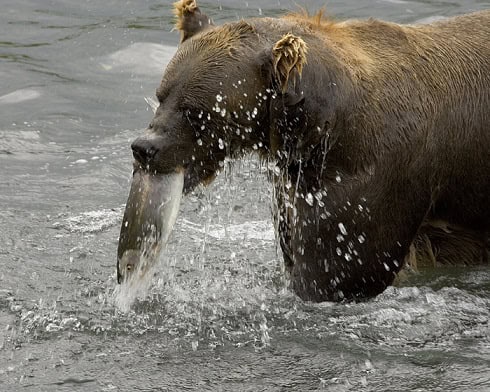
The bottom line is that to make it through the frigid hibernation season, a bear must eat a year’s worth of food in six months. There’s no room for kicking back and doing adverts for Chobani yogurt (like Whopper the bear). Consequently, the hungriest bears in the world can devour 30 salmon a day, which translates to roughly 150 pounds of tasty fish. 747 is a classic hungry bear, who resides by Brooks Falls in Alaska and was awarded the prestigious Fat Bear trophy in 2020. One day in 2018, he was spotted eating 18 salmon in just 2 hours, and by the end of the day, he had reached 30.
Recently, there’s been a big problem with mercury contamination in fish, but scientists have put it to good use in the grizzly world. The average bear sheds its fur once a year during early summer, and by analysing the mercury content of its long brown hairs, scientists can determine roughly how much salmon its diet contains. On Kodiak Island, the average grizzly bear clocked in at a gigantic 6146 pounds per year. Adult females reached 3007 pounds, while subadults ate significantly less, reaching 1248 for females and 1305 pounds of salmon for males.
Kodiak island is famous for its bountiful salmon buffet, which is why those waving teddy bears on youtube videos are so gigantic, but the bears of Katmai National Park are similarly gluttonous.
| 2 | Why salmon in particular? |
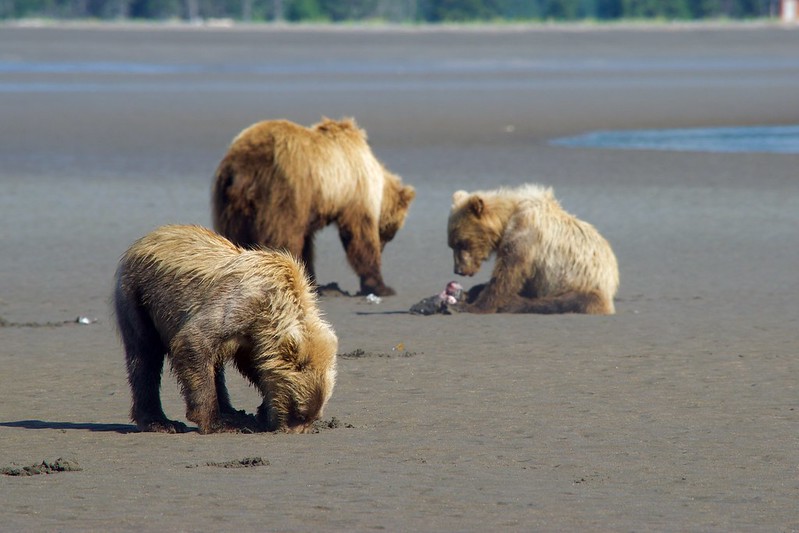
It’s all down to a strange anomaly of nature: the yearly salmon run, an epic cycle of migration which scientists don’t fully understand. All salmon are born in rivers, and over the first 12 weeks of life, their bodies undergo changes which make them more adapted to salt water. Once they reach 15-20cm long, the young salmon break free from their river nests, flowing through mountains and forests at high speeds, before spending the next 4 years of their lives at sea.
Eventually though, breeding time arrives. Thus, the salmon turns around and performs the miraculous feat of swimming upstream to the river shallows, sometimes reaching the exact spot it was born in. The salmon must jump up waterfalls and travel hundreds of miles, in thick, dense schools containing thousands of other fish. After breeding and laying fresh eggs, the salmon then dies after constant exposure to fresh water gradually takes its toll, its life cycle fulfilled.
But that’s without considering the bears. During summer, bears are at the height of hyperphagia, the intense season of feeding where their appetite is never fully satisfied. Unlike squirrels or voles, bears don’t eat a morsel during hibernation – they rely solely on their stored body fat. Bears can gain as much as 3 pounds of fat per day, and combined with the fish’ natural oiliness and high calorie count, the vast supply of summer salmon flowing past is too good an opportunity to miss.
| 3 | The salmon capital of the world |
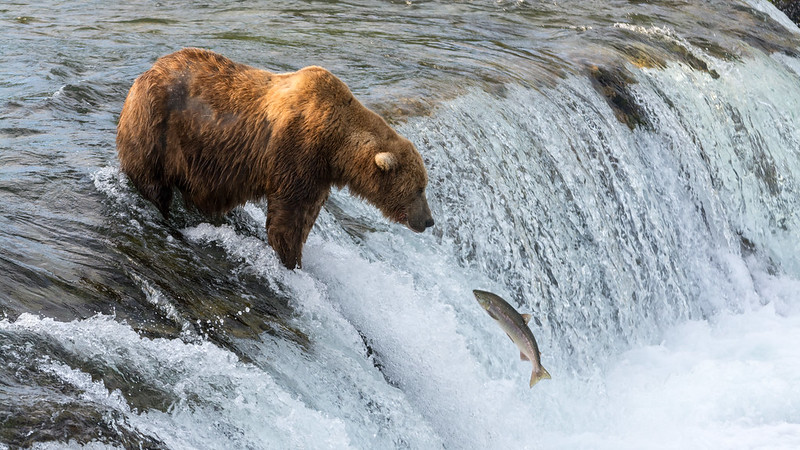
Alaska has numerous salmon hotspots, including Kodiak island, where the shores are so rich with fish that the grizzlies grow to be 1600 pound monsters. But perhaps the most famous hotspot is Brooks Falls in Katmai National Park, where explore.org has installed a live bear cam which beams its images to youtube all summer long.
For 8 years now, the Brooks Falls webcam has kept people entertained with its stories of bear fights, bear play sessions, and fiercely competitive bear fishing. At any given time, Brooks Falls may have 30-40 bears fishing for salmon, particularly in June and July, barely tolerating each other’s presence. Brooks Falls is also popular with tourists, with special wooden viewing platforms, and consequently, the bears there are unusually tolerant of people. But it’s the other bears they have to worry about, and the younger, less dominant bears which can’t compete usually move to lower, less concentrated sections of the Brooks river.
It was estimated that in 2018, 62 million sockeye salmon migrated through Katmai National Park. Places like Brooks Falls are perfect for bears, because the waterfalls create a temporary barrier for the salmon, which they must haltingly jump up. Yet the salmon supply isn’t always guaranteed for grizzlies. For example, July 2019 was the warmest month in Alaska ever recorded. The high temperature was 27.6C, blasting through the previous record of 24.4C. This caused many salmon schools to die in their rivers, floating to the surface dead, unable to take the heat stress.
| 4 | The ever varying fishing techniques |

How do bears get their paws on these fast, slippery salmon so easily? The first technique is simply sitting, where bears wait for the salmon to swim past, before pinning them to the rocky floor or their furry bodies and getting stuck in. For example, the most coveted location in Brooks Falls is easily the plunge pools directly below the waterfall, particularly the “jacuzzi”. The larger, most dominant bears will hog these spots and intimidate any smaller bears that dare to come close.
The opposite of sitting is standing, and bears will often stand at the rocky tops of falls, waiting for salmon swimming upstream to jump in order to catch them in mid-air. Bears will usually choose a position and rarely shift from it, because the risk of falling on the slippery rocks and breaking bones is all too real. The water is typically a raging flood which would wash away humans instantaneously.
Snorkelling is another popular technique, when a bear will swim on the river surface with its face submerged under. This is particularly common during fall or late summer, when scores of dead of dying fish are floating just below the surface.
Then there’s dash and grab – where a hungry grizzly chases after fish after noticing them in shallower waters. This is the most direct fishing method, with no gimmicks, just pure paw to eye coordination. but it’s also very unreliable, and expends too much energy to use repeatedly.
| 5 | Diving, the ultimate bear skill |
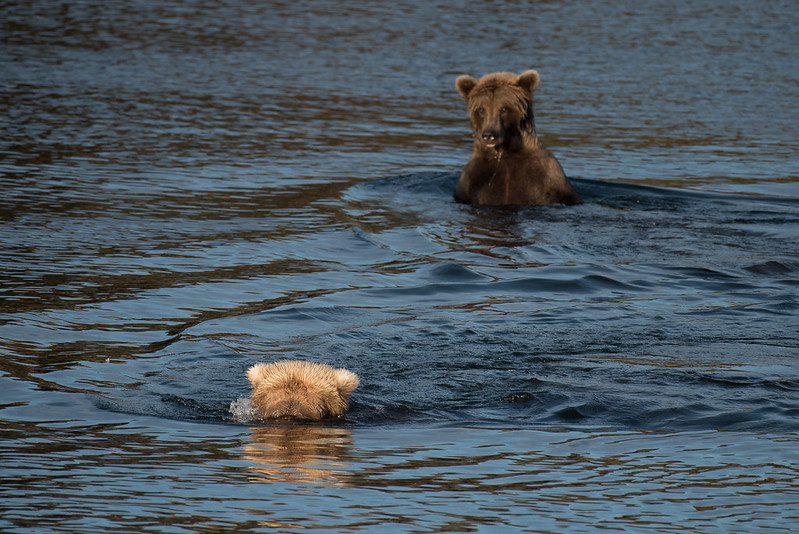
The final fishing technique is diving, when a bear will completely disappear underwater. This is a rare method, because it requires extreme precision, and is unnecessary when so many schools of fish are swimming past at the peak of the season, ready to grab. Plus, bears hate to get their ears wet! Scientists still haven’t worked out why, but one theory is that water damages a bear’s hearing, and another is that wet ears are somehow uncomfortable for bears. A snorkelling bear will always keep its ears above water.
Nevertheless, rogue bears will occasionally master the diving technique, such as Diver 001, who was active during the 1980s and 1990s and could reach schools of fish inaccessible to most bears. Consequently, Diver 001 was a very fat bear. It was estimated that he lived to be 35 years old, with his last sighting by Brooks Falls being in 2001.
Recently, the diving mantle has been taken over by 487 Ted, and bear 402. First identified in 2000, she was spotted diving 5 times in this 2013 video, with her cubs watching on (and learning?). Why some bears become so excellent at diving is a mystery. It could be a niche which they’ve chosen and gradually become highly practiced in, or it might be genetic – natural instincts and reflexes which make catching salmon easier for some bears while diving.
| 6 | Without bears, the salmon would suffer |
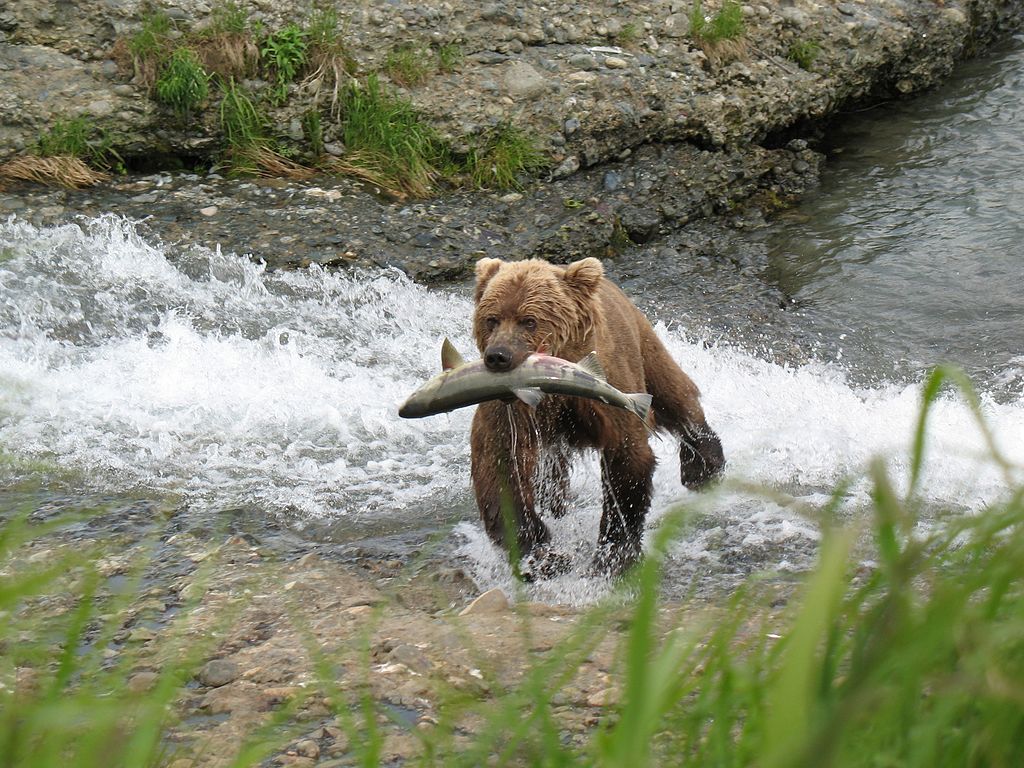
A brown bear never gets sick of its constant salmon feasts. In fact, the more they eat, the more excited they get. Through binoculars, bears have visible expressions of joy on their faces as they leap through the air towards their waiting salmon prey, whose heads they break apart on the slimy rocks with gusto. There’s a close correlation between salmon numbers in the water and how many cubs a mother bear will have the following year.
The relationship is so tight that in the 1940s and 50s, the government considered culling the number of bears in Alaska, to boost the fishing industry. It’s not all fun and games though: bears can easily get infected by tapeworms from eating raw salmon.
Believe it or not, bears are helpful to the salmon species overall. Without the millions of carcasses being scavenged, they would clog the riverbed and lead to poisonous fungal overgrowths, which would devastate the salmon eggs nestled there.
Grizzlies have even been spotted hunting salmon in Idaho, schools which had gone rogue and swum up to unusually high altitude mountain streams. That said, there are no salmon in the grizzly bear hotspot of Yellowstone park, except for 7000 land-locked salmon which were introduced in 1980 and rapidly died out.
| 7 | Secrets of the salmon world |
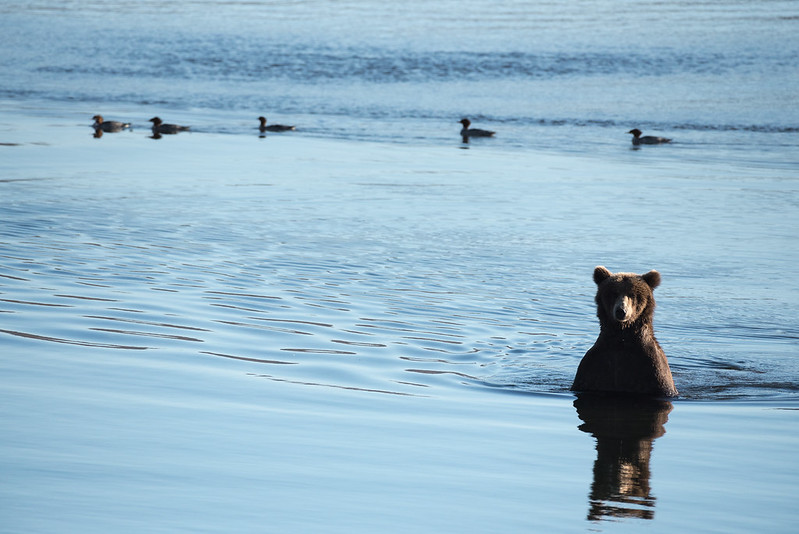
Sometimes, a bear will eat the fresh fish in its paws instantly, but other times, they’ll separate from the hungry grizzly pack and walk a few meters into the nearby forest. There, the grizzly will eat around 25% of the salmon’s body. One surprising thing is how carefully a brown bear removes the salmon’s skin, which they always eat first. Only a chef’s knife could be as precise.
A salmon’s brain is extremely rich in fat, and therefore, brain is second on the menu for a bear in its summer fattening stages. The roe is almost as high in fat, but the entrails and bones are ignored unless the bear is desperately hungry. Bears have no fears over choking on salmon because the bones are naturally soft, only hardening during cooking, which bears are not generally known for.
Consequently, bear researchers tiptoeing around the rivers usually find decapitated salmon carcasses lying around in droves. In the summer months, the rivers are often so overflowing with salmon that they’ll take a few bites and leave the rest.
Scientists have analysed the soil in trees directly adjacent to bear rivers and discovered that 70% of the forests’ nitrogen (a building block nutrient of most life) comes from salmon carcasses. In fact, the spruce tree forests by salmon rivers are commonly three times as tall. Near Brooks Falls, the giant spruce trees have been dubbed the “salmon trees”.
| 8 | Salmon theft is a crime |
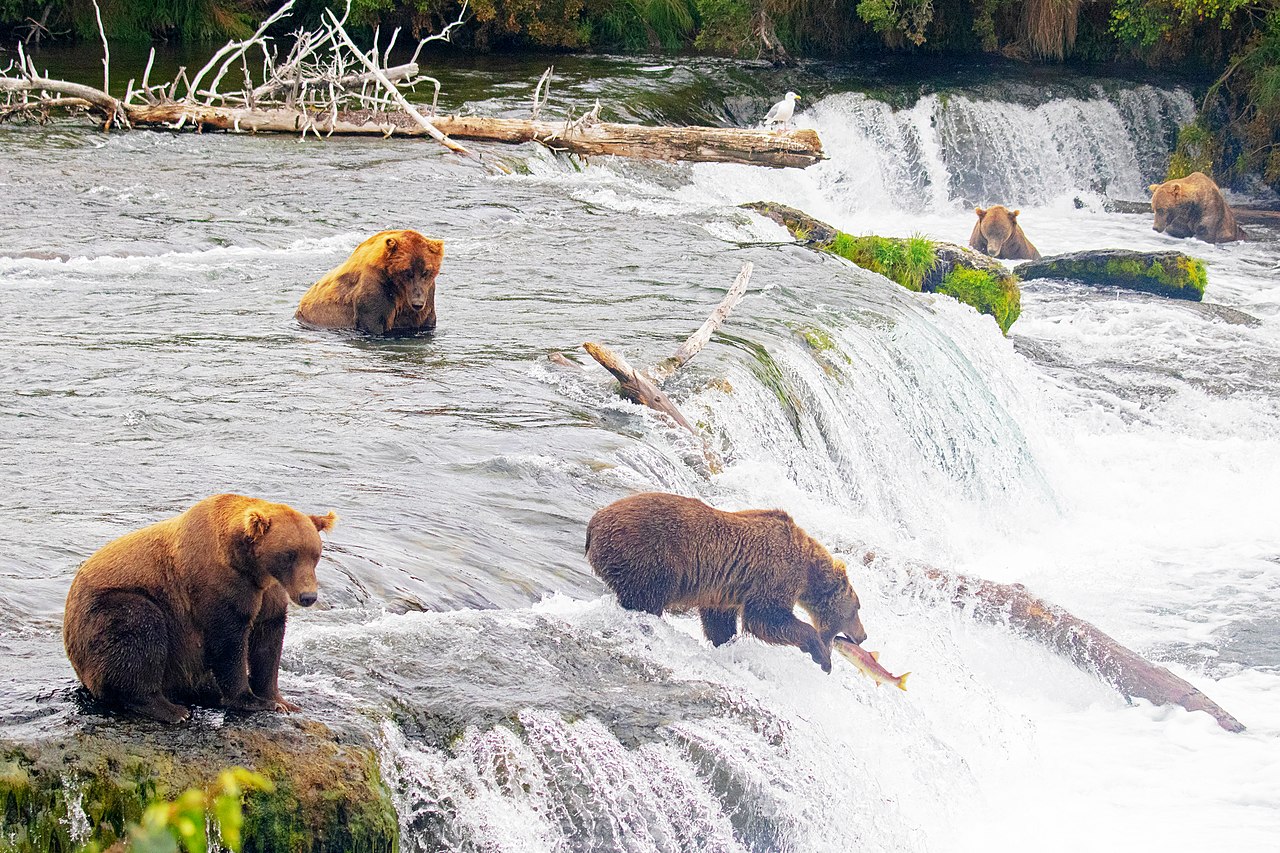
On the bear cams of Brooks Falls, or the non-existent bear cams of the rest of Alaska, bears commonly duel over salmon which has already been caught. The fights usually start with posturing, with body language vastly different to our own, with bears staring at the ground and drooling. The next second, they’ll leap onto their hind legs and begin what looks like a cuddly wrestling match, but with paws swiping at lightning speed.
Typically, this lasts for a minute before the larger and heavier bear (but not always) manages to force the smaller one back. Bears rarely kill outright for salmon, although they do wound the other bear. The battle is normally won when the less dominant bear submits and leaves. This loser could be the successful fisherman, or a failed challenger.
Battles come in all shapes and sizes, such as in November 2013 when a grizzly was photographed in Katmai trying to grab a salmon directly out of its opponent’s jaws. The two bears were evenly matched, and the fisherman bear got to keep what was rightfully his.
However, most tussles are fought over prime fishing spots, before any salmon is fished. The larger, dominant bears will protect their rocky outcrops or plunge pools at all costs, and brutally assault those who dare to challenge them. The smaller bears are usually smart enough to stay away.
| 9 | Fish theft part 2 |
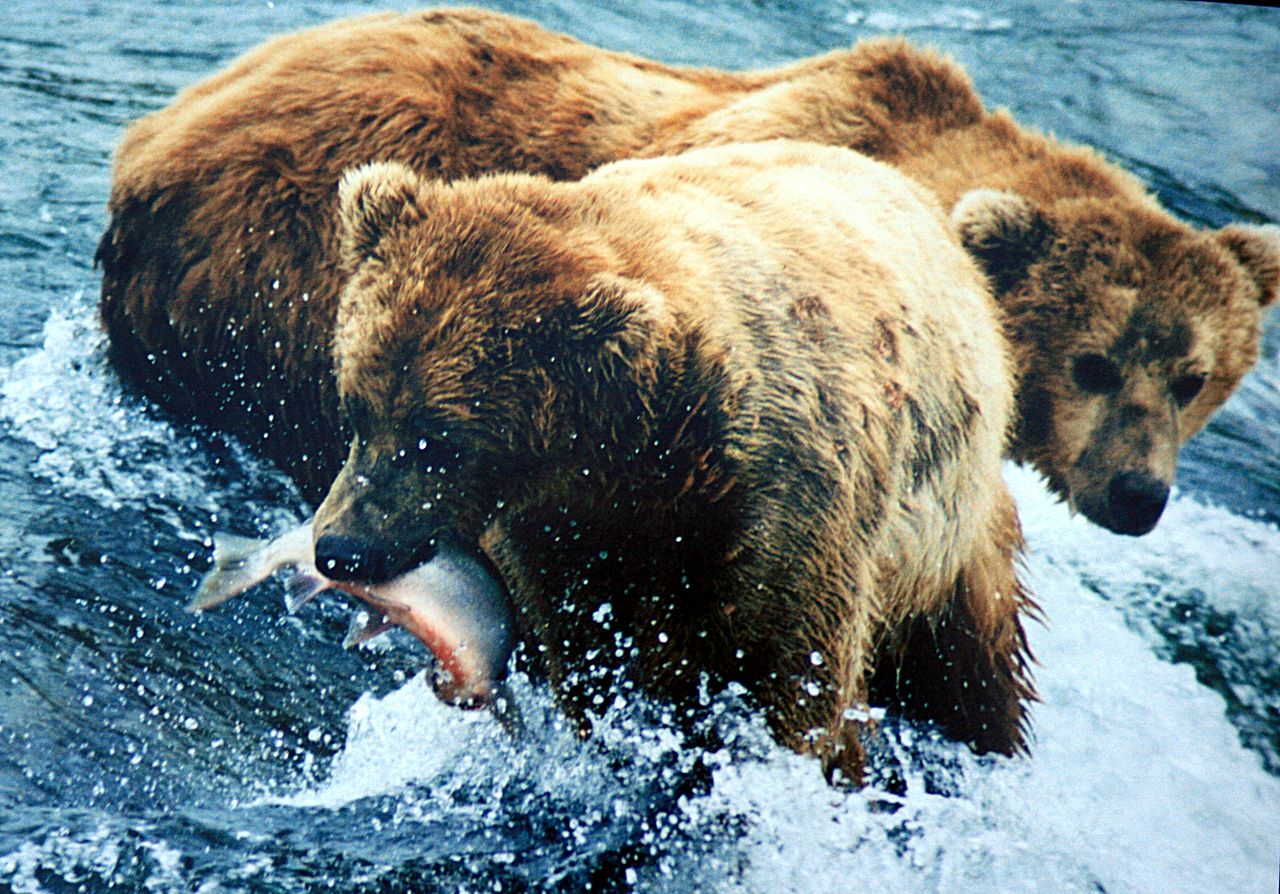
For some bears, stealing fish seems to be a way of life. The famous Headbob the bear (last seen in 2010) was an occasional salmon burglar, but for 209 One Toe, theft had become second nature, and he had the scars all over his body to prove it (his name kind of gave the game away). One Toe was actually seen coughing up blood in October 2008, before dying next to Brooks Falls river, a rare event to be caught on camera.
420 Genghis was huge and aggressive around other bears, and was also keen on stealing. In 2007 though, he was spotted with a broken lower jaw which affected his salmon-chewing abilities. Proving that crime doesn’t pay, he was only sighted from 2001 to 2010, compared to the 2 decade reign of 001 Diver. Our final notorious bear burglar was 775 Lefty, who particularly liked to steal from the female bears, but otherwise preferred to hone his fishing technique. 775 Lefty still lives today.
Because bears return to hotspots like Brooks Falls year after year, many come to remember their fellow species members and dominance hierarchy they fit into. Sometimes though, a bear might come back 50 pounds heavier and start to fancy its chances again. When he was first spotted, 480 Otis was hesitant and weak while hunting salmon, but from 2005-2010, he was king of the fishing castle, before being displaced in the hierarchy by two young guns called 747 and 856.
| 10 | Fishermen beware |

If you love to get out in nature, then know this fact: nothing will stand in the way of a bear’s quest for salmon. In 2020, fisherman Adam Blomfield was sitting by the shores of an Alaskan lake when a huge grizzly bear approached. At first, the bear left him alone, but seconds later, it had hooked its jaws around the fresh salmon attached to Blomfield’s fishing wire. “Oh my god, this stresses me out!” said an unidentified voice. Blomfield remained calm, and wisely let the fish go, causing the bear to run off into the forest with its dinner.
Jeremy Wade was equally shocked while filming his “River Monsters” fishing show. He was relaxing by a wide spacious river in Alaska, when the telltale red blur appeared below the surface. He prepared to reel a salmon in, only for a rare blonde grizzly bear to show up on the opposite shore. It didn’t charge, but ambled around menacingly, while getting slowly closer.
Blomfield knew that his catch was toast, and so he gradually reeled the fish in towards his pebble strewn island. Finally, the bear pounced in shallow water, before disappearing into the undergrowth with its prize. But minutes later, it was back for more. The camera zoomed in dramatically on a pistol in the hand of Wade’s friend. “Cover your eyes” someone said, before a loud bullet shot caused the blond bear to flee instantly. “All part of the day in the life of a fisherman”, said Wade.

Leave a Reply